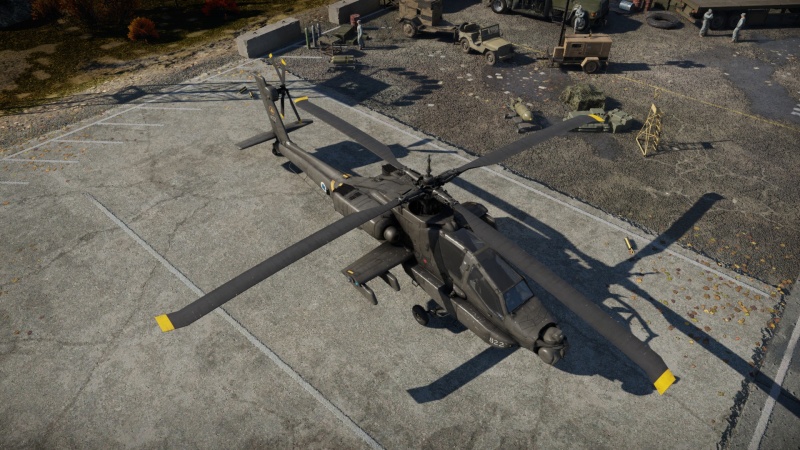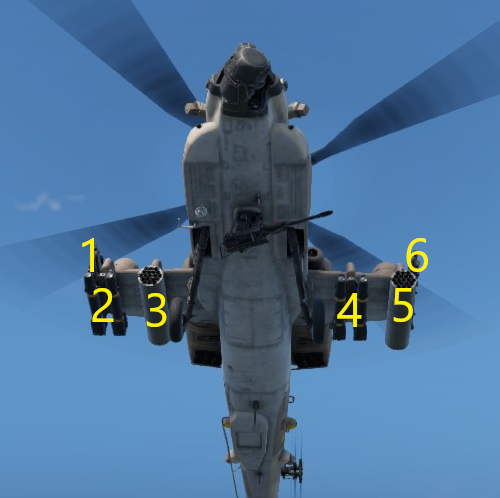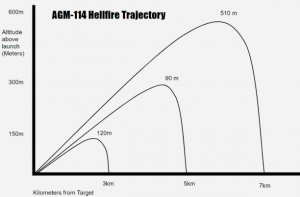AH-64A Peten (Israel)
| This page is about the premium attack helicopter AH-64A Peten (Israel). For other versions, see AH-64 (Family). |
Contents
Description
Israel was involved in the Apache program since 1983. A prototype was sent to Israel for testing and concluded in Israel being the first nation to receive the AH-64A aside from the United States. The first helicopters arrived on September 11, 1990, these units where assembled in 11 hours, half the time recommended, to be ready for its welcoming ceremony. By the 2000s, Israel operated 42 AH-64A helicopters. The name "Peten" translates to "Cobra", the same nickname used by the AH-1. The AH-64 was rapidly put into service and participated in Operation Accountability in Lebanon, Operation Grapes of Wrath against Hezbollah in Lebanon, killing senior figures in Hamas during the al-Aqsa Intifada in the 2000s and in many other scenarios against Israel's enemies. The IAF upgraded its AH-64As to the AH-64Ai in 2013, a standard similar to the AH-64D.
Introduced in Update "Wind of Change", the AH-64A has a very good flight performance like all attack helicopters and it's able to fire the lethal Hellfire ATGMs. With a total of 16 Hellfire missiles, it's very capable of dealing with threats even with enemy SPAA deployed around the battlefield. Additionally, even though the ATAS (AIM-92) lacks the manoeuvrability of other air-to-air missiles, it compensates this with a very good range and a precise and capable seeker head, so it is usually hard to flare for enemy jets with afterburners engaged. All pilots flying the Apache, as well as other attack helicopters, should be aware of threats and enemy positioning to stay alive, it's very important having constant situational awareness and keep an eye on the sky to watch for potential enemy fighters trying to cover the area. The AH-64A s also equipped with an IRCM, this is very helpful to deal with IR guided missiles. It doesn't mean that flares are not needed, but it means that when combined with flares and evasive manoeuvres, it becomes much easier to get rid of incoming IR missiles, particularly against IRCCM-equipped missiles such as the AIM-9M and R-73.
General info
Flight performance
| Characteristics | Max Speed (km/h at 1,000 m) |
Max altitude (metres) | |
|---|---|---|---|
| AB | RB | ||
| Stock | 275 | 257 | |
| Upgraded | 326 | 300 | |
Survivability and armour
The Peten is a very tough helicopter, and can usually take a couple of hits from air-to-air missiles and small-calibre cannon rounds and still fly. The crew is very well protected, so getting pilot-sniped is a rare occurrence. The engines can also usually take a hit or two without exploding like other engines.
Modifications and economy
Armaments
| Ballistic Computer | ||
|---|---|---|
| CCIP (Guns) | CCIP (Rockets) | CCIP (Bombs) |
| |
|
|
Offensive armament
The AH-64A Peten (Israel) is armed with:
- A choice between two presets:
- 1 x 30 mm M230E-1 cannon, chin turret (1,200 rpg) + 30 x countermeasures
- 1 x 30 mm M230E-1 cannon + 30 x countermeasures + IRCM
The Peten has the same 30 mm cannon as the other Apaches in the game currently, and only has one belt choice. The belt carries only HEDP rounds, and can penetrate up to 51 mm of armour. The gun is fast firing, but relatively inaccurate, so shooting in close range is the best way to hit your target. If you don't mind the inaccuracy of the gun, it is a very good weapon all around. It can be locked in gunner and 3rd person view and will automatically track the target.
Suspended armament
The AH-64A Peten (Israel) can be outfitted with the following ordnance:
| 1 | 2 | 3 | 4 | 5 | 6 | ||
|---|---|---|---|---|---|---|---|
| Hydra-70 M247 rockets | 19 | 19 | 19 | 19 | |||
| AGM-114B Hellfire missiles | 2, 4 | 2, 4 | 2, 4 | 2, 4 | |||
| ATAS (AIM-92) missiles | 2 | 2 |
| Default weapon presets | |
|---|---|
| |
The Peten can carry up to 16 Hellfire ATGMs with over 1,000 mm of pen, 76 Hydra rockets with over 200 mm of pen, or 4 Stinger AAMs. The weapons are carried on the stub wings and can be carried in several different variations. The Hellfires are excellent missiles, although since the player must keep "painting" a laser beam on the target, misses can occur if the target lock slips. The Hydra rockets are generally very effective, especially when used with the ballistic computer. 76 rockets is enough for 3-5 tanks if they are used by an experienced player. However, the Stinger AAMs are not the best in the game by any stretch, with relatively little explosive mass and only a 10G overload. They may take 2-3 hits to damage aircraft, and heavily armoured helicopters such as the Mi-28 may survive multiple hits.
Usage in battles
Overview:
The AH-64A Peten is an excellent helicopter for attacking ground targets, and can also hold its own against many enemy aircraft. Through adequate use of cover, teamwork, and game sense, the Apache can easily dismantle enemy teams. An Apache pilot must understand all of the tools at their disposal. The only difference between the Peten and the tech tree AH-64A is that the Peten lacks access to the AIM-9L Sidewinders as an ordnance option.
The Apache has an arsenal of weapons. The most effective anti-tank weapon in the Apache's arsenal is the AGM-114 Hellfire, which uses a top attack trajectory to destroy ground vehicles. There is functionally very little difference between the AGM-114B and K variants, used on early and late Apaches respectively.
Staying Alive:
Flying the Apache effectively can be more difficult than most players would imagine. Trying to deal with threats from enemy air and ground vehicles while continuing to attack the enemy team can be difficult. If distracted, a pilot can quickly lose situational awareness. Being successful in the Apache requires situational awareness above all else. Due to the fragility of the helicopter, any blindspot can lead to a quick and sudden death. Additionally, the mobility of the Apache is adequate but not impressive, so evasive manoeuvres are not always effective.
Using cover is a very important part of staying alive in the Apache. Always stay behind a hill or building in ground battles. When exposing yourself in order to fire on the enemy, be mindful to not gain too much altitude. Most importantly, Always listen to your RWR. If you hear an alarm, take evasive action immediately.
Additionally, it is important to know when to use flares. Flares are extremely effective against heat-seeking missiles, but useless against any other missiles. It is the responsibility of the Apache pilot to recognize the threat and decide whether to use flares or not.
Air-to-Air (Stinger and Gun):
The Apache is surprisingly potent in air-to-air combat. Engagements should be conducted primarily through the use of the AIM-92 Stinger missiles. The Stinger is a simple but effective air-to-air missile. It has an excellent seeker head and can obtain all aspect lock on almost any air target within 3-5 km (even propeller aircraft with a low heat signature). However, the Stinger can be easily fooled by flares or outmanoeuvred by a fast enemy aircraft. The best way to use the Stinger against enemy aircraft is when they are heading directly towards you. If fired at the right second, most enemies will struggle to dodge a Stinger.
If the enemy gets close, the 30 mm autocannon can be extremely effective. The gun will automatically aim with optical lock, so Apache pilots can aim accurately while taking evasive manoeuvres.
Close Range Air-to-Ground (Gun and Rockets):
At close range, the Apache has excellent offensive capability. The 30 mm autocannon is incredibly accurate even at surprisingly far distances. This cannon uses a High Explosive Dual Purpose round that can engage lightly armoured targets. Rocket pods can also be used, with the CCIP computer helping maintain accuracy even at further distances. Be careful when trying to use the Hellfire missile at close range. It can do a direct attack at closer ranges (rather than its usual top attack) but if fired at an odd angle, it may not have time to manoeuvre onto the target if fired at closer ranges.
The problem with trying to engage at close range is that doing so will put the Apache in huge amounts of danger. Enemy tanks will be able to quickly destroy the Apache with their main guns or anti-aircraft machine guns.
Long Range Air-to-Ground (Hellfire):
At longer ranges, the Hellfire missile can be used to full effect. The Hellfire will guide on its target as shown in the attached diagram. This is known as top attack. Being that it takes this path to the enemy target, the Hellfire can take upward of 30 seconds to reach its target at longer ranges. Do not fire at enemies that are about to move to cover, and make sure to fire multiple missiles at once in order to deal maximum damage. Because the Hellfire is laser guided, multiple missiles can be fired at once. They should be fired at intervals of 5-10 seconds, where between missiles the Apache can switch to a new ground target. This will allow for the quick destruction of multiple enemies. This tactic can be incredibly effective. Although the time to target for the most recently fired Hellfire is available on the HUD, pilots will have to keep track of all the missiles they have fired by memory and quick calculations.
Combatting enemy anti-aircraft vehicles can be a challenge. Always remain in cover and move unpredictably in combat. Use the radar warning receiver to obtain the general direction of enemy AA, and then attack with a Hellfire. An effective strategy is to fire a Hellfire, break optical lock to gain cover and avoid counterfire, and then pop back up and get lock again several seconds before the Hellfire hits. This strategy if applied correctly will result in a hit, as the Hellfire is smart enough to begin following the laser designator again once the Apache re-obtains its lock.
Pros and cons
Pros:
- Activation of 3rd person lock by changing MFD on the pilot's view
- Very high top speed, if you stay low or high you are always the most manoeuvrable
- Amazing 30 mm cannon, can easily take out most tanks, and when locked can take out jets and helicopters too
- Excellent secondary armament
- Can carry up to 16 Hellfires and still carry AAMs
- Can use ballistic computer to dramatically increase the effectiveness of Hydra rockets
- Can lock targets for 30 mm cannon to automatically track
- Excellent thermals
- Well armoured for a helicopter, can take 2-3 critical hits to take it down, may survive hits from SAMs
Cons:
- Stinger air to air missiles don't have a reliable lock, and not enough explosive mass to do any real damage
- Hellfires rarely hit other helicopters, and are difficult to guide to air targets anyway
- Does not have as many armament options as non-premium AH-64s
- 30 mm cannon only can access default belt
- 30 mm cannon is relatively inaccurate
- AAMs cannot reliably take down armoured helicopters
History
Israeli involvement in the Apache programs goes back to June 1983, when a prototype for the AH-64A Apache was sent to Israel for flight testing (by Israeli pilots) and testing of the aircraft in desert conditions. The testing directly resulted in a recommendation by the Israeli Air Force (IAF) for purchase of the Apache in order to increase the IAF's anti-tank capabilities.
Israel became the first nation to have received the AH-64A Apache - other than the US - on 11 September 1990, when the first helicopter arrived. The first nation on the list for export had been Kuwait, but when Iraq invaded Kuwait in August 1990 the order was delayed. The first two helicopters were assembled in eleven hours - half the time that McDonnell Douglas recommended - and they arrived a day before the planned welcoming ceremony. By 2000, the IAF was operating 42 AH-64As. The AH-64A in Israeli service is known as the AH-64A Peten, which translates to 'Cobra'.
The AH-64A was put into service, and its first combat action occurred on 24 October 1990, with an attack on suspected terrorist positions. AH-64A Petens were used heavily during the 1993 Operation Accountability in Lebanon. They also participated in the 1996 Operation Grapes of Wrath against Hezbollah in Lebanon. On 13 April 1996, AH-64s killed six civilians when they fired two Hellfire missiles at an ambulance. Israeli AH-64s were used to kill senior figures in Hamas during the al-Aqsa Intifada in the 2000's. During the 2006 Lebanon War, IAF Apaches were used again to launch strikes against Hezbollah in Lebanon. The Apache saw heavy combat during the 2008 Operation Cast Lead, fighting against Hamas in Gaza. Israeli Apaches have been used to patrol the skies of Gaza, and often carried out strikes there against insurgents.
The IAF AH-64A began to be upgraded to the AH-64Ai standard in 2013, comparable to the AH-64D - which has also been used by the IAF since 2005. The IAF currently operates over 40 AH-64 helicopters in two squadrons.
Media
- Skins
- Videos
See also
- Related development
External links
Paste links to sources and external resources, such as:
- topic on the official game forum;
- other literature.
| Boeing Aircraft | |
|---|---|
| Aircraft | |
| Fighters | P-26A-33 · P-26A-34 M2 · P-26B-35 |
| Bombers | B-17E · B-17E/L · B-17G-60-VE |
| B-29A-BN | |
| Export | P-26A-34 · B-17G |
| Captured | ▅B-17E |
| Helicopters | |
| Attack | AH-64A · AH-64D |
| Export / Licensed | AH-64A (GR) · ▃AH-64A Peten · AH-64A Peten · ▅AH-64DJP · ▄AH Mk.1 · AHS |
| See Also | Tupolev Design Bureau · Westland Helicopters · Fuji Heavy Industries |
| For Boeing-built ships, see Boeing Marine Branch | |
| Israel helicopters | |
|---|---|
| Attack | |
| MD 500 | Lahatut |
| Battle Hawk | AH-60 |
| Cobra | Tzefa D/E · Tzefa A · Tzefa B |
| Apache | Saraph · Peten · AH-64A Peten |







